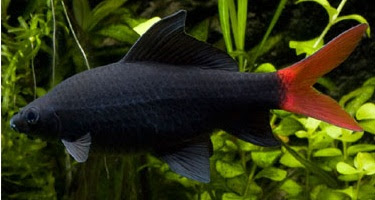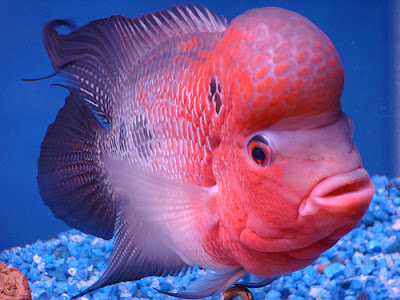The fighter fish (betta fish) is a popular species of freshwater
aquarium fish. It is originally known as Siamese fighting fish and
popular in US as ‘Betta’. This word is derived from Ikan Bettah – a
local dialect of Thailand. In Thai, “Plakat Morh” or “Trey Krem” means Fighting Fish. This fish species is the native of Thailand, Indonesia, Malaysia, Vietnam, Cambodia, and parts of China.
So, first things first, there is much debate on which size of a tank
you should actually keep your Betta Fish in. From my experience you
should have no less than a 3 gallon tank to give them maximum amount of
movement and space to grow and move around.
Remember, a happy Fighter Fish is one that has lots of space to move around and frolic in all its fish-like glee.
To fully understand what the perfect Fighter Fish Diet is you first have to understand where the Fighter Fish is originally from. These awesome fish have received the nick name “The Jewel Of The Orient”,
their native home is originates from Thailand but they can also be
found in their natural habitat in and around Malaysia, Indonesia,
Vietnam and parts of China.
They like to hang out around small, shallow ponds and even some slow
moving streams. While there is some debate about which is actually the
best possible habitat for your Fighter Fish, one thing that is often
over looked is the actual water temperature. In their home countries the
average water temperature is about 80ºF, so that is their ideally
perfect water temp.
As the water starts to cool the Fighter Fish will get increasingly
more agitated, which can really lead them to live up to their name.
Fighter Fish have been known to fight to the death just because the
other Betta Fish looked at them the wrong way. So be sure to keep their
water temperature right at 80ºF and you’ll be fine. That’s why you
shouldn’t keep them in a small bowl, because you cannot regulate the
heat control very well. I highly recommend getting a top of the line
Fighter Fish Aquarium.
Back in Thailand, you would find the Betta Fish feeding on all kinds
of cool fish food like insects and insect larva. In a perfect world
that’s all they would eat. But if need be they will adapt to eating the
dry flake foods found at your local pet store or even freeze dried food
if that’s all ya got.
However, the BEST food you can ever feed your Betta Fish is live
insects. They will love that stuff and will eat it all day. Their
digestive system are geared towards primarily consuming meat so when you
can, give them the good stuff.
The healthier, more live food you give your Fighter Fish the more their colors will pop and the happier they will be.
They actually have a upward turned mouth made specifically for eating
any unlucky bugs that happen to fall in the water. What you wanna try
to do as a Fighter Fish owner is replicate their natural habitat as much
as possible. By feeding them live bugs, you can do this and they’ll
love you for it.
Some of the best things you can feed these little guys are Brine
shrimp, Daphnia, plankton, tubifex, glassworms, and beef heart. Those
are all great things to feed your Fighter Fish, you can find them either
frozen or freeze dried. Either one will do nicely. But if you have
flake food, you’ll need to suppletment with either freeze dried, frozen
or preferably live food.
Some of my favorites are the freeze dried blood worms. Betta Fish go
bonkers for these nasty little worms and will be sure to really brighten
up their colors too.

Fighter Fish Breeding – The Best Breeding Technique
Fighter Fish
have a fairly short life span, living on average between 2 to 5 years,
so if you are planning on breeding them its best to do it while they are
under a year old so you will yield the best offspring. Most of the
Betta Fish that you will find in pet shops are typically about 6 months
old.
Most breeders feel that a 10 gallon tank or bigger works great, just
make sure its bare bottom so the Fighter Fish can make their little
bubble nests with ease. You definitively want to avoid using any kind of
pebbles in the tank when breeding as the eggs may end up falling
through them and dying.
If you really wanna get some great offspring then you’ll need to
precondition your Betta Fish for breeding by feeding them a ton of live
food. The water should have a PH of exactly 7 and have a temperature no
colder than 80ºF, you can got a few degrees hotter if you would live
too.
Whats going to happen next is the male will blow an elaborate bubble
nest, they look really cool. At this point you’ll need to create a
little hiding place for the female as the males can get kinda aggressive
when its time to mate. It’s actually not that uncommon for the female
to loose a few scales or have a few nips taken out of her tail.
Just make sure that after the breeding session is over that you
remove the female from the tank because the male Fighter Fish have been
known to kill the female Betta while he is tending to the bubble nest.
When the pair is ready to spawn their colors will become extremely
vibrant and the male Betta Fish will start to circle the female under
the bubble nest. Then the male will wrap himself around the female after
she has been flipped to her back. As she excretes the eggs they will
become fertilized by the male and will begin to float to the bottom on
the tank.
Next the male will gently scoop up the eggs and spit them into the
bubble nest where they can finally hatch over the course of the next few
days. From this point on the male Betta Fish will tend to the young and
the female most definitively needs to be removed from the tank because
this is when the male is most aggressive.
In the next few days the male Fighter Fish will continue to watch
over the nest making sure to spit back in any eggs that fall out of the
bubble nest, but in the next 2 or 3 days the eggs will hatch and the
young fry will be swimming around the tank with Daddy. At this point,
you’ve gotta remove the male fish because he might eat the young, and
there goes your whole spawn.
Now that you’ve got an open tank, the fry should be fed a few times
daily preferably with baby brine shrimp as they contain the best
nutrients for the young broods. For the nest you should use some kind of
Tetra mix as it does great for the bubble nests and resembles the Fighter Fish’s natural habitat. And take care about not over feeding the fry because if you do it will pollute the water.
Fighter Fish Types By Color
Green:

Green is the least fixed single color and varies in shade from fish to fish and line to line. Most Green
Betta Splendens
have a bluish green hue but less so than a Turquoise variant. It is
often difficult to distinguish these two hues because they really do
look quite similar and also depends on the angle you look at them.
Make sure you go after the dark green
Fighter Fish, they a prime choices. This and the turquoise hues derive
from the same alleles (BlBl). But the much sought after, dark, forest
green is very rare. If you happen to come by one then I highly
recommend you pick it up right away.
Reds:
Solid red Betta Fish have non
iridescent color and must have that color spread over the entire body,
evenly for it to count. What you really want to get is a clean read,
without iridescent colors and absolutely no fading.

However reds can come in many different
hues ranging from a bright and beautiful fire engine red to shades of
deep crimson and even reddish brown colors. yet, color will always vary
between breeds, usually most red Betta Fish end up showing some
iridescence or show a little bit of other colors creeping in.
If there is any opaque overlay is will distract from the bright red and will tend to show more pinks and muted reds.s.
Of all the red Fighter Fish out there, a
brilliant cherry red is by far the most desired, with no iridescence or
opaque color to take away from the solid red. Usually the red loss
occurs as they age, being bright red as fries but as they grow, it
gradually lessens, getting more dull with time.
Royal Blue & Corn Flower Blue:

The consistent, solid royal blue is
the choice form: the genotype Blbl or blBl gives adeep, rich royal blue
in the green/steel blue/royal blue complex. The most common form has a
dark head and royal blue body and fins. The ideal color lacks reds
and greens.
Corn-flower blues are the same genotype as royal blues but with a dark head and corn-flower blue body.
Royal blues with red factors may
appear violet or purple when young and will lose it if the red-loss
factor is present and so produce royal blues. Red loss occurs also
occurs in Steel Blue, Turquoise, and Green.
Black:

A true black Fighter Fish has a deep,
dark and mysterious shade of black to it, all the way around. However,
it is often times more of a smokey black and you will even see black
Betta Fish with transparent, smokey looking fins.
Black is one of the most difficult
colours to achieve, as the melano gene produces infertile Black females.
Several crosses with other colours have tried to alleviate this
problem, e.g. Melano x Celophane or yellows.
Getting a true black Fighter Fish can
prove to be very difficult though, because the black or Melano gene
products infertile black female Betta Fish. And even attempting several
crosses with other species has not really solved the problem.
Steel Blue:
Steel Blue Betta Fish are created by
crossing the allele combination blbl, this creates a metallic iridescent
glow when compared to the Royal Blue Betta Fish.

Steel Blue, Green, Royal Blue, Green
and Turquoise Betta’s have an interesting genetic inheritance pattern
based on the Bl / bl alleles that show incomplete dominance and
determine iridescence.
Many Fighter Fish, such as the Royal
Blue, Turquoise, Steel Blue, Royal Blue and Green all show and
interesting incomplete dominance and determined iridescence based on the
genetic inheritance pattern Bl /bl.
Examples Of Betta Fish Genetic Crossings:
Steel Blue x Steel Blue gives 100% Steel Blue off-spring;
Green x Green gives 100% Green;
Green x Steel Blue gives all Royal Blue;
Royal Blue x Royal Blue gives 50% Royal, 25% Steel, 25% Green;
Green x Royal Blue gives 50% Royal, 50% Green.
Steel Blue x Royal Blue gives 50% Royal, 50% Steel Blue
Turquoise is a variation of the “green” coloring (BlBl alleles).
Turquoise:

A variant of the green, with a distinct
blue hue. Consistent color across the fish is rare. The choice color
contains tones of blue rather than any Green or Yellow shades, to
distinguish them from the common green.
Fish with colors close to turquoise are often found in Royal Blue and Steel Blue spawns.
The ideal is a dark shade of turquoise.
Opaques aka Pastels

You’ll know a Opaque or Pastel Fighter
Fish when you see once because it will have this sort of milky white
overlay that seems to dilute any of the underlying colors to more of a
pastel type of shade, this usually includes the eyes in most cases.
What’s really cool to know is that
there is an opaque or pastel from of each of the main color types. All
that the breeder needs to do in order to trigger this type of color is
make sure the Op allele is present and you’ll have yourself an awesome
looking pastel Betta Fish.
Pastels can be almost any pastel color.
Yellow

Brilliant lemon yellows or even a
butter yellow are the best yellow colors produced so far, although some
breeders claim to have produced a golden yellow. Colors that tend to be
either a very pale yellow or a yellow-brown tinted are inferior colors.
Yellow results from a gene that transforms red so sometimes the presence of red is also visible.
Golden yellow Fighter Fish, with golden
iridescence, are rare. In some Betta Fish, like the yellow/apricot
strain, only the operculum is iridescent gold.
A lutino form exists, in which the eyes are yellow, too.
Apricot And Peach:
These are yellow pastels of varying intensities.

Apricot yellows have a distinct pale orange tint to the yellow.
Some yellow Bettas show a faint orange tint to the fins and are called Apricot.
To continue the fruity colours, “Pineapple” Bettas are yellows with a
distinct black outline to the scales, giving a net-like or pineapple
appearance. Pineapple Bettas are pattern form, not a colour type.
Albino:

Rare. A characteristic of any true Albino fish is that the body lacks all pigmentation, including the eyes which appear red.
Like Cellophane, these are completely
colourless fish and may appear pinkish white or solid white if the
opaque factor is present. True albino Bettas have red eyes, with no
pigmentation and may show a little bit of color if they are very
translucent due to their organs wand what not.
If you ever have the chance to come up
on an Albino then I highly recommend you do because they are VERY hard
to find and even harder to breed. Take a big time advantage and jump at
the opportunity to get one.
White:

Some White Fighter Fish may be
completely solid in color and are a true beautiful dense white because
of the opaque factor in their pigments. You’ll be able to tell the sure
fire difference between a white and an albino every time because albinos
will always have red eyes and true whites will always have black ones.
The image to the right shows a truly
perfect white Betta Fish, yet it may still have some weird coloration
with blues and black due to the way the light is hitting the Fighter
Fish in the photo.
Just always remember that whites of this type have black eyes and true albinos have red eyes. Don’t be fooled.
Chocolate:

Chocolate
Betta splendens look
brown to the eye, but are actually a black and yellow mix and are one
of my favorite colors you’ll find on the Fighter Fish.
While the Chocolates are not are rare
as the dark forest green Betta or the Albino Fighter Fish, it’s still a
pretty tough one to come by sometimes, usually because most people
just don’t have the chocolate color ones around.
If you want to help improve the color
of the Chocolate Fighter Fish you can actually breed it with a yellow
one to try and increase the vibrancy of both the yellow and the
chocolate fry.
Orange:

Orange Fighter Fish are actually a new
strain of Betta Splendens, and for some reason each breeder seems to
think about the shade of orange a little bit differently. I have never
really seen a true orange Betta Fish, except in pictures. Most of the
ones I see are more like a light reddish orange or more of a deep
Halloween type orange color that tends to be more yellowish red and
orange.
But none the less, all forms of the
Orange Fighter Fish still look really really cool and I would most
definitively keep one of them in my fish tank without question. They are
yet another hard strain to come by, so if you find a true orange one,
make sure you do everything you can to get it.
But the real question is… How “orange” is orange?
In my opinion, true orange is the
spectrum right in between red and yellow. I always think of Halloween
and pumpkins when talking about orange so maybe my view is a little
slanted, but then again, maybe it’s right on target, what do you think?
Lavender:

A lavender Betta is genetically a Cambodian
Betta Splendens with extended Red and a layer of light iridescent blue-green.
Truly Purple Betta Splendens are also
very new and rare and it appears that the color results from blending
red and blue, just like you would get from blending some water colors
together. Nature always works the same way.
The Royal Blue strain throws purple or
violet fry that appear violet at their first show of color and darken to
royal blues within a few months, as the red fades (due to the red-loss
factor, L) as the fish mature .
Truly violet colored Betta Fish are
rare. So again, if you find one for sale or a breeder with one. Do what
you can to get some off spring. It will be WELL worth it.
So there you have it, those are
virtually all the different color combination you will find. Keep in
mind these are the basic main color combos out there, many breeders will
cross black with yellow for example to make really cool looking Fighter Fish that are totally unique. They are always coming out with new strains and new colors.







































